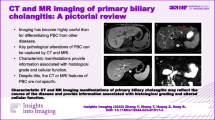Abstract
Objectives
The purpose of this study is to evaluate high-resolution ultrasound and magnetic resonance imaging (MRI) in monitoring of cholangiocarcinoma in the hamsters with C. sinensis infection and N-nitrosodimethylamine (NDMA).
Materials and Methods
Twenty-four male Syrian golden hamsters of were divided into four groups composed of five hamsters as control, five hamsters receiving 30 metacercariae of C. sinensis per each hamster, five hamsters receiving NDMA in drinking water, and nine hamsters receiving both metacercariae and NDMA. Ultrasound was performed every other week from baseline to the 12th week of infection. MRI and histopathologic examination was done from the 4th week to 12th week.
Results
Cholangiocarcinomas appeared as early as the 6th week of infection. There were 12 cholangiocarcinomas, nine and ten of which were demonstrated by ultrasound and MRI, respectively. Ultrasound and MRI findings of cholangiocarcinomas in the hamsters were similar to those of the mass-forming intrahepatic cholangiocarcinomas in humans. Ultrasound and MRI also showed other findings of disease progression such as periductal increased echogenicity or signal intensity, ductal dilatation, complicated cysts, and sludges in the gallbladder.
Conclusions
High-resolution ultrasound and MRI can monitor and detect the occurrence of cholangiocarcinoma in the hamsters non-invasively.
Key Points
• High-resolution ultrasound and MRI can monitor occurrence of cholangiocarcinoma in the hamsters.
• Cholangiocarcinomas were detected as early as the 6th week after C. sinensis infection.
• Axial T2-weighted MRI demonstrated cholangiocarcinomas and various inflammatory findings in the hamsters.






Similar content being viewed by others
Abbreviations
- CCA:
-
cholangiocarcinoma
- CS:
-
Clonorchis cinensis
- FA:
-
flip angle
- FOV:
-
field of view
- GRE:
-
gradient-echo
- HASTE:
-
half-Fourier acquisition single-shot turbo spin-echo
- MRI:
-
magnetic resonance imaging
- NEX:
-
number of excitation
- NDMA:
-
N-nitrosodimethylamine
- PACE:
-
prospective acquisition correction
- SPAIR:
-
spectral adiabatic inversion recovery
- TE:
-
echo time
- TR:
-
relaxation time
- TSE:
-
turbo spin-echo
- T1WI:
-
T1-weighted image
- T2WI:
-
T2-weighted image
- US:
-
Ultrasound
- VIBE:
-
volumetric interpolated breath-hold examination
References
Jemal A, Center MM, DeSantis C, Ward EM (2010) Global patterns of cancer incidence and mortality rates and trends. Cancer Epidemiol Biomarkers Prev 19:1893–1907
Shin HR, Oh JK, Lim MK et al (2010) Descriptive epidemiology of cholangiocarcinoma and clonorchiasis in Korea. J Korean Med Sci 25:1011–1016
Lee JH, Rim HJ, Bak UB (1993) Effect of Clonorchis sinensis infection and dimethylnitrosamine administration on the induction of cholangiocarcinoma in Syrian golden hamsters. Korean J Parasitol 31:21–30
Lee JH, Yang HM, Bak UB, Rim HJ (1994) Promoting role of Clonorchis sinensis infection on induction of cholangiocarcinoma during two-step carcinogenesis. Korean J Parasitol 32:13–18
Najm I, Trussell RR (2001) NDMA formation in water and wastewater. J Am Water Works Assoc 93:92–99
Lee JH, Rim HJ, Sell S (1997) Heterogeneity of the “oval-cell” response in the hamster liver during cholangiocarcinogenesis following Clonorchis sinensis infection and dimethylnitrosamine treatment. J Hepatol 26:1313–1323
Plengsuriyakarn T, Eursitthichai V, Labbunruang N et al (2012) Ultrasonography as a tool for monitoring the development and progression of cholangiocarcinoma in Opisthorchis viverrini/dimethylnitrosamine-induced hamsters. Asian Pac J Cancer Prev 13:87–90
Hanpanich P, Pinlaor S, Charoensuk L et al (2013) MRI and (1)H MRS evaluation for the serial bile duct changes in hamsters after infection with Opisthorchis viverrini. Magn Reson Imaging 31:1418–1425
Hanpanich P, Pinlaor S, Charoensuk L et al (2015) MRI and (1)H MRS findings of hepatobilary changes and cholangiocarcinoma development in hamsters infected with Opisthorchis viverrini and treated with N-nitrosodimethylamine. Magn Reson Imaging 33:1146–55
Chung YE, Kim MJ, Park YN et al (2009) Varying appearances of cholangiocarcinoma: radiologic-pathologic correlation. Radiographics 29:683–700
Seale MK, Catalano OA, Saini S et al (2009) Hepatobiliary-specific MR contrast agents: role in imaging the liver and biliary tree. Radiographics 29:1725–1748
Kim R, Lee JM, Shin CI et al. (2016) Differentiation of intrahepatic mass-forming cholangiocarcinoma from hepatocellular carcinoma on gadoxetic acid-enhanced liver MR imaging. Eur Radiol 26:1808–17
Koh J, Chung YE, Nahm JH et al (2016) Intrahepatic mass-forming cholangiocarcinoma: prognostic value of preoperative gadoxetic acid-enhanced MRI. Eur Radiol 26:407–416
Choi D, Hong ST, Li S et al (2004) Bile duct changes in rats reinfected with Clonorchis sinensis. Korean J Parasitol 42:7–17
Hong ST, Park KH, Seo M et al (1994) Correlation of sonographic findings with histopathological changes of the bile ducts in rabbits infected with Clonorchis sinensis. Korean J Parasitol 32:223–230
Aishima S, Oda Y (2015) Pathogenesis and classification of intrahepatic cholangiocarcinoma: different characters of perihilar large duct type versus peripheral small duct type. J Hepatobiliary Pancreat Sci 22:94–100
Yu MH, Lee JM, Yoon JH et al (2013) Clinical application of controlled aliasing in parallel imaging results in a higher acceleration (CAIPIRINHA)-volumetric interpolated breathhold (VIBE) sequence for gadoxetic acid-enhanced liver MR imaging. J Magn Reson Imaging 38:1020–6
Kim KW, Lee JM, Jeon YS et al (2013) Free-breathing dynamic contrast-enhanced MRI of the abdomen and chest using a radial gradient echo sequence with K-space weighted image contrast (KWIC). Eur Radiol 23:1352–1360
Acknowledgments
The scientific guarantor of this publication is Joon Koo Han. The authors of this manuscript declare no relationships with any companies, whose products or services may be related to the subject matter of the article. This study has received funding by the National Research Foundation of Korea (NRF) grant funded by the Korea government (MSIP) (no. 2009-0083512). No complex statistical methods were necessary for this paper. Institutional Review Board approval was not required because this study was on animals. Approval from the institutional animal care committee was obtained. Methodology: experimental.
Author information
Authors and Affiliations
Corresponding author
Rights and permissions
About this article
Cite this article
Woo, H., Han, J.K., Kim, J.H. et al. In-vivo monitoring of development of cholangiocarcinoma induced with C. sinensis and N-nitrosodimethylamine in Syrian golen hamsters using ultrasonography and magnetic resonance imaging: a preliminary study. Eur Radiol 27, 1740–1747 (2017). https://doi.org/10.1007/s00330-016-4510-4
Received:
Revised:
Accepted:
Published:
Issue Date:
DOI: https://doi.org/10.1007/s00330-016-4510-4




